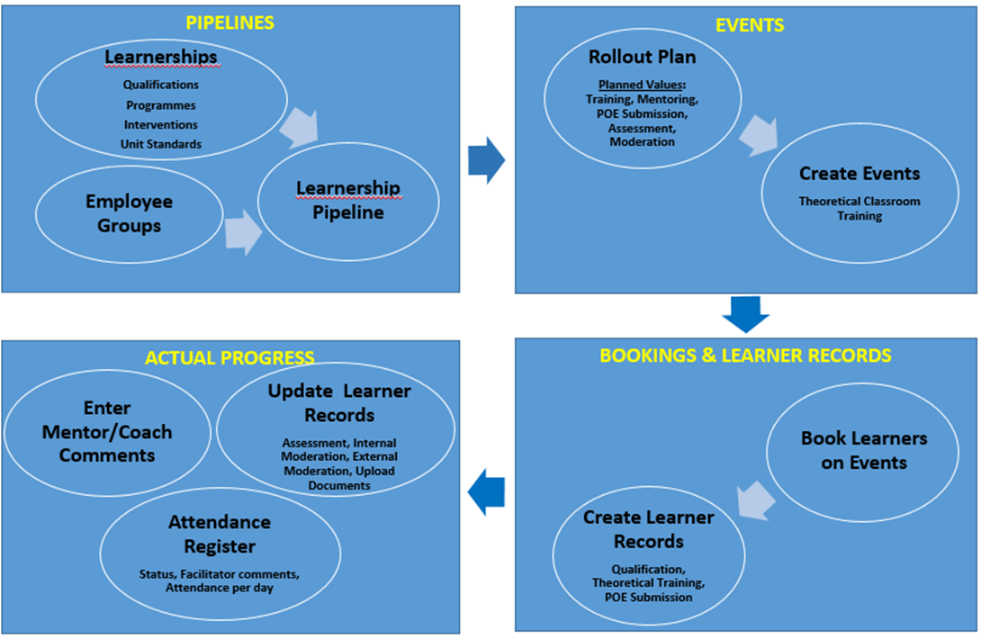Specialist Tips on Picking the Right LMS Learnership for Your Needs
Specialist Tips on Picking the Right LMS Learnership for Your Needs
Blog Article
Strategic Execution of LMS Learnership Programs for Sustainable Staff Member Advancement
In the world of workforce growth, the strategic execution of Learning Administration System (LMS) learnership programs stands as a linchpin for fostering sustainable staff member development within organizations. By delving into the intricacies of making and executing LMS learnership programs with a critical lens, companies can unlock a variety of advantages that not just boost worker abilities but additionally contribute to the total sustainability and success of the business.
Advantages of LMS Learnership Programs
LMS learnership programs offer a plethora of benefits for both staff members and organizations looking for continuous specialist development. Furthermore, these programs typically provide a broad variety of programs and sources, allowing workers to obtain brand-new abilities and expertise pertinent to their roles or profession aspirations.
Furthermore, LMS learnership programs advertise a culture of constant understanding within companies (lms learnership). On the whole, the benefits of LMS learnership programs extend beyond private growth to encompass the alternative advancement of both workers and the companies they offer.

Secret Methods for Application
Building upon the fundamental advantages highlighted earlier, effective implementation of learnership programs requires critical preparation and implementation to optimize their effect on staff member advancement and business growth. One key method for successful execution is straightening the learnership program with the company's general objectives and goals. By guaranteeing that the program's content and structure are in sync with the business's critical direction, workers are more probable to see the significance of their engagement and how it adds to the bigger picture.
One more important technique is to protect buy-in from top administration and vital stakeholders. Management assistance not only gives the needed sources and funding but additionally sends out a message to staff members regarding the program's significance. Additionally, developing a durable communication strategy that describes the program's framework, advantages, and expectations helps in handling participant and stakeholder assumptions, promoting engagement, and keeping openness throughout the execution procedure. Regular surveillance and assessment of the program's performance are likewise necessary to make timely changes and guarantee its continued success.
Gauging Program Effectiveness
Reliable measurement of the learnership program's effect is crucial for assessing its total performance in boosting employee advancement and adding to organizational development. To measure program performance, essential efficiency signs (KPIs) require to be developed. These KPIs should straighten with the program's objectives and the organization's calculated goals. Usual KPIs for determining the efficiency of learnership programs consist of employee engagement degrees, understanding retention rates, abilities improvement, and performance enhancements. Studies, analyses, and responses mechanisms can be click here for more utilized to gather quantitative and qualitative information on these KPIs.

Overcoming Execution Obstacles
To guarantee the successful execution of learnership programs and optimize their effect on worker development, organizations need to resolve and conquer various obstacles that may emerge throughout the implementation phase. One common difficulty faced is resistance from staff members who may be hesitant to participate in brand-new learning initiatives. This can be mitigated through clear communication about the anchor advantages of the program and addressing any concerns raised by team.
An additional obstacle is the lack of resources, both in terms of spending plan constraints and time constraints. Organizations can overcome this by focusing on the allotment of sources towards the learnership program and looking for external funding or collaborations to sustain its execution.
Moreover, guaranteeing active engagement and engagement from both workers and management is crucial for the success of the program. This can be attained through developing clear goals and expectations, providing recurring support and responses, and acknowledging and rewarding achievements. By proactively my sources attending to these implementation obstacles, organizations can enhance the performance and sustainability of their learnership programs for worker development.
Making Sure Long-Term Sustainability
To guarantee the long-lasting sustainability of LMS learnership programs, companies must focus on a number of vital aspects. It is essential to consistently evaluate the efficiency of the program with performance metrics, participant feedback, and alignment with company goals.
Incorporating the learnership program right into the company's lasting calculated planning ensures that it obtains the necessary resources, buy-in from leadership, and alignment with the organization's future instructions. By taking an aggressive and all natural method to the sustainability of LMS learnership programs, organizations can grow a skilled and agile workforce capable of fulfilling the challenges of tomorrow.
Verdict
To conclude, the critical implementation of LMS learnership programs is essential for sustainable staff member development. By focusing on advantages, key approaches, measuring efficiency, overcoming difficulties, and making certain long-lasting sustainability, companies can create a structured technique to sustain continual knowing and development. This strategy enables employees to improve their abilities and expertise, ultimately causing improved efficiency and performance within the organization.
Report this page